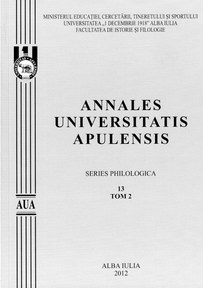Modele străine de terminologie în vechile gramatici româneşti
Foreign Terminology Patterns in the Old Romanian Grammars
Author(s): Andreea DrişcuSubject(s): Language and Literature Studies
Published by: Universitatea »1 Decembrie 1918« Alba Iulia
Keywords: grammar; lexic; loan translation; the eighteenth century; neologisms; scientific style
Summary/Abstract: The paper aims to illustrate ways in which terminology is created in the old Romanian grammar books and the way in which they have been influenced by similar papers from other cultures. New terms are usually formed through loan translation from foreign models. Neologisms are used in the normative papers of the nineteenth century. The most important sources for the first grammar books are the Slavonic, Greek and Latin ones, which offer not only ways of organizing the Romanian grammars but also terminology models. In the first Romanian normative papers most of the terms are lexical or semantic loan translation, because of the lack of native terminology. Gradually, the old grammar nomenclature was used simultaneously with the one based on neologisms, this phenomenon being registered in the texts beginning with the eighteenth and ninetheenth centuries. I have elaborated a limited list of examples of terms, taking in consideration some theories about the loan translation, in order to classify them according to the source and the specificity of each one. The examples have been selected especially from Radu Tempea’s Gramatica românească (1797) and from other similar papers as: Dimitrie Eustatievici Braşoveanul’s Gramatica limbii rumâneşti from 1757 and Ienăchiţă Văcărescu’s Observaţii sau băgări de seamă asupra regulelor şi orînduielelor gramaticii româneşti from 1787. This research reveals the pressure from other cultures’ normative papers and, at the same time, the difficulties of adapting foreign terms to the Romanian system. These aspects are added due to the fact that until 1861 (when the Latin script is officially adopted), the Romanian language has been written with the Cyrillic graphy, which often proved to be inconstant. Considering the lack of a proper terminology, an Academy which organizes the normative writing papers process, a printing activity which supports and disseminates secular books, a consistent didactic literature, a large number of Romanian schools, the loan translation usage is justified. Even if they have an inconstant structure and a difficult meaning, the loan translation facilitates understanding of the terms, which is an important aspect, taking into consideration the fact that they were used as teaching books. Unlike them, neologisms facilitate the international circulation of grammatical terms.
Journal: Annales Universitatis Apulensis. Series Philologica
- Issue Year: 13/2012
- Issue No: 4
- Page Range: 277-294
- Page Count: 18
- Language: Romanian

